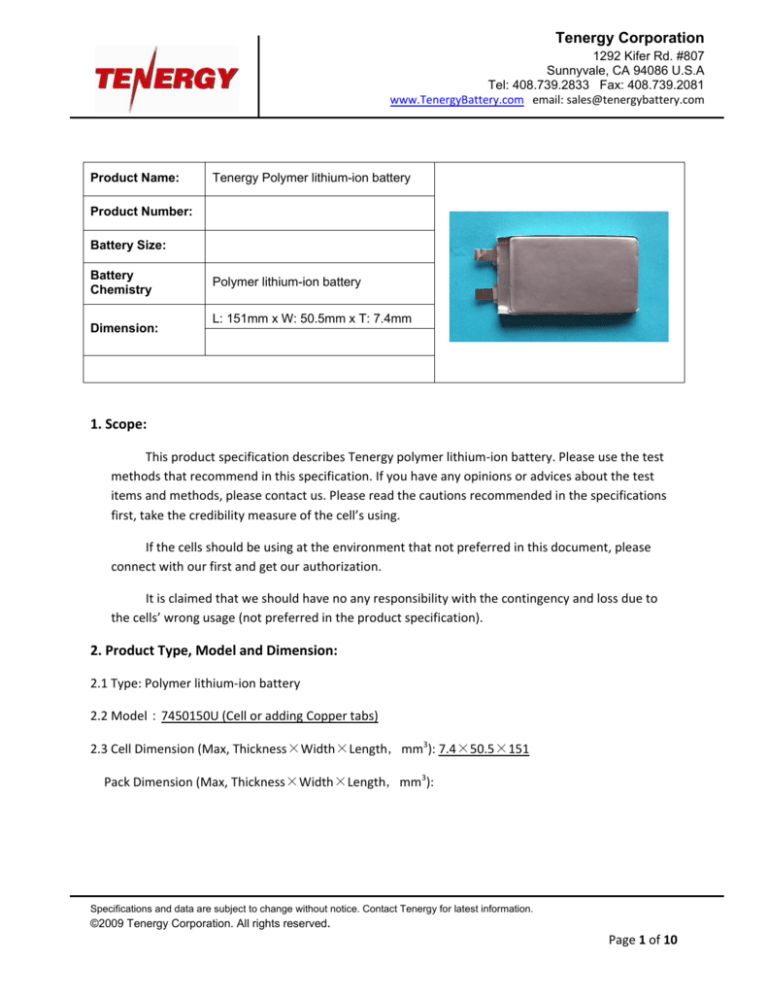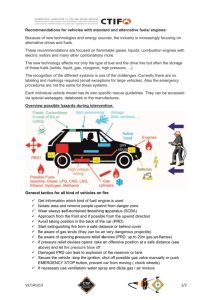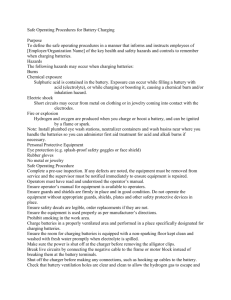
Tenergy Corporation
Product Name:
1292 Kifer Rd. #807
Sunnyvale, CA 94086 U.S.A
Tel: 408.739.2833 Fax: 408.739.2081
www.TenergyBattery.com email: sales@tenergybattery.com Tenergy Polymer lithium-ion battery
Product Number:
Battery Size:
Battery
Chemistry
Dimension:
Polymer lithium-ion battery
L: 151mm x W: 50.5mm x T: 7.4mm
1. Scope: This product specification describes Tenergy polymer lithium‐ion battery. Please use the test methods that recommend in this specification. If you have any opinions or advices about the test items and methods, please contact us. Please read the cautions recommended in the specifications first, take the credibility measure of the cell’s using. If the cells should be using at the environment that not preferred in this document, please connect with our first and get our authorization. It is claimed that we should have no any responsibility with the contingency and loss due to the cells’ wrong usage (not preferred in the product specification). 2. Product Type, Model and Dimension: 2.1 Type: Polymer lithium‐ion battery 2.2 Model:7450150U (Cell or adding Copper tabs) 2.3 Cell Dimension (Max, Thickness×Width×Length,mm3): 7.4×50.5×151 Pack Dimension (Max, Thickness×Width×Length,mm3): Specifications and data are subject to change without notice. Contact Tenergy for latest information.
©2009 Tenergy Corporation. All rights reserved. Page 1 of 10 Tenergy Corporation
1292 Kifer Rd. #807
Sunnyvale, CA 94086 U.S.A
Tel: 408.739.2833 Fax: 408.739.2081
www.TenergyBattery.com email: sales@tenergybattery.com 3. Specification: Item Specifications Remark Nominal :5100 mAh Typical Capacity 25℃,0.2C5A discharge Min:5000 mAh Nominal Voltage 3.7V 25℃,Average Voltage at 0.2C5A discharge Charge Current Standard:0.2 C5A;Max:1C5A Working temperature:0~45℃ Charge cut‐off Voltage 4.200±0.05V Discharge Current Continuously:15C5A;Max:20C5A Working temperature:0~60℃ Discharge cut‐off Voltage 2.75V Cell Voltage 3.7~3.9V When leave factory Impedance ≤10mΩ 25℃,AC 1KHz after 50% charge Weight Approx115g ≤1month Storage temperature ‐20~45℃ ≤3month 0~30℃ ≤6month 20±5℃ Storage humidity Best 20±5℃ for long‐time storage 65±20% RH Specifications and data are subject to change without notice. Contact Tenergy for latest information.
©2009 Tenergy Corporation. All rights reserved. Page 2 of 10 Tenergy Corporation
1292 Kifer Rd. #807
Sunnyvale, CA 94086 U.S.A
Tel: 408.739.2833 Fax: 408.739.2081
www.TenergyBattery.com email: sales@tenergybattery.com 4. General Performance: Definition of Standard charging method: At 20±5℃,charging the cell initially with constant current 0.2C5A till voltage4.2V, then with constant voltage 4.2V till current declines to 0.05C5A. Item Test Methods Performance After standard charging, laying the battery 0.5h, then discharging at 0.2C5A to voltage 2.75V, recording the discharging time. 4.1 0.2C Capacity 8.6 After standard charging, laying the battery 0.5h, then 15C Discharge discharging at 5C5A to voltage 2.75V, recording the discharging time. ≥300min ≥3.6min 4.3 Cycle Life Constant current 1C5A charge to 4.2V, then constant voltage charge to current declines to 0.05C5A, stay 5min,constant current 1C5A discharge to 2.75V,stay 5min. Repeat above steps till continuously discharging time less than 36min. 4.4 Capability of keeping electricity 20±5℃, After standard charging, laying the battery 28days, discharging at 0.2C5A to voltage 2.75V, recording the discharging time. ≥300times ≥240min 5. Environment Performance: Item Test Methods Performance 5.
1 High temperature After standard charging, laying the battery 4h at 60℃, then discharging at 0.2C5A to voltage 2.75V, recording the discharging time. ≥270min 5.
2 Low temperature After standard charging, laying the battery 4h at ‐
20℃, then discharging at 0.2C5A to voltage 2.75V, recording the discharging time. ≥210min 5.
3 After standard charging, laying the battery 48h at Constant humidity and 40±2℃, RH 93±2%. Recording 0.2C5A discharging temperature time No distortion No electrolytes leakage Specifications and data are subject to change without notice. Contact Tenergy for latest information.
©2009 Tenergy Corporation. All rights reserved. Page 3 of 10 Tenergy Corporation
1292 Kifer Rd. #807
Sunnyvale, CA 94086 U.S.A
Tel: 408.739.2833 Fax: 408.739.2081
www.TenergyBattery.com email: sales@tenergybattery.com ≥270 min After standard charging, battery stored at ‐20℃ for 2 Temperature hours, then stored at 50℃ for 2 hours. Repeat 10 shock times. 5.
4 No electrolytes leakage 6. Mechanical Performance: Item Test Methods Performance Vibration After standard charging, put battery on the vibration No influence to batteries' table. 30 min experiment from X,Y,Z axis. Scan rate: 1 electrical performance and oct/min; Frequency 10‐30Hz, Swing 0.38mm; Frequency appearance. 30‐55Hz, Swing 0.19mm. 6.2 Collision After vibration test, batteries were laying on the vibration table about X, Y, Z axis. Max frequency acceleration: 100m/s2; collision times per minutes: 40~80; frequency keeping time 16ms; all collision times 1000±10. No influence to batteries' electrical performance and appearance. 6.3 Drop Random drop the battery from 10m height onto concrete one times. No explosion or fire 6.1 7. Safety Test: Test conditions: The following tests must be measured at flowing air and safety protection conditions. All batteries must standard charge and lay 24h. Item Test Methods Performance No explosion or fire No explosion or fire 7.1 Over charge At 20±5℃, charging batteries with constant current 3C5A to voltage 4.8V, then with constant voltage 4.8V till current decline to 0. Stop test till batteries’ temperature 10℃ lower than max temperature. 7.2 Over discharge At 20±5℃, discharge battery with 0.2C5A continuously 12.5h. Specifications and data are subject to change without notice. Contact Tenergy for latest information.
©2009 Tenergy Corporation. All rights reserved. Page 4 of 10 Tenergy Corporation
1292 Kifer Rd. #807
Sunnyvale, CA 94086 U.S.A
Tel: 408.739.2833 Fax: 408.739.2081
www.TenergyBattery.com email: sales@tenergybattery.com 7.3 Short‐circuit At 20±5℃, connect batteries’ anode and cathode by wire which impedance less than 50mΩ, keep 6h. No explosion or fire 22.2 Extrusion At 20±5℃, put the battery in two parallel steal broad, add pressure 13kN. No explosion or fire Put the battery in the oven. The temperature of the oven Thermal shock is to be raised at 5±1℃ per minute to a temperature of 130±2℃ and remains 60 minutes. 7.5 No explosion or fire 8. Cautions: 8.1 Cautions of batteries’ operation The batteries must be careful of proceed the operation for it’s soft package. 8.1.1 Aluminum packing materials The aluminum packing material was easily damaged by the sharp edge part, such as nickel‐tabs. Sealed edge Package material Folding edge Anode Ni‐tab Transforming Ni‐tab Cathode Al‐tab Fig.1. Exterior schematic of polymer lithium‐ion cells Specifications and data are subject to change without notice. Contact Tenergy for latest information.
©2009 Tenergy Corporation. All rights reserved. Page 5 of 10 Tenergy Corporation
1292 Kifer Rd. #807
Sunnyvale, CA 94086 U.S.A
Tel: 408.739.2833 Fax: 408.739.2081
www.TenergyBattery.com email: sales@tenergybattery.com (1) Forbid to use the sharp part touching the battery; (2) Should cleaning working condition, avoiding the sharp edge part existence; (3) Forbid to pierce the battery with nail and other sharp items; (4) The battery was forbidden with metal, such as necklace, hairpin etc in transportation and storage. 8.1.2 Sealed edge Sealing edge is very easily damaged and don’t bend it. The Al interlayer of package has good electric performance. It’s forbidden to connect with exterior component for preventing short‐circuits. 8.1.3 Folding edge The folding edge is formed in batteries’ processes and passed all hermetic tests, don’t open or deform it. The Al interlayer of package has good electric performance. It’s forbidden to connect with exterior component for preventing short‐circuits. Al interlayer Reverse folding insulated Fig.2. Single folding edge schematic of PL cells Fig.3. Reverse folding edge schematic of PL cells 8.1.4 Tabs The batteries’ tabs are not so stubborn especially for aluminum tabs. Don’t bend tabs. Specifications and data are subject to change without notice. Contact Tenergy for latest information.
©2009 Tenergy Corporation. All rights reserved. Page 6 of 10 Tenergy Corporation
8.1.5 Mechanical shock 1292 Kifer Rd. #807
Sunnyvale, CA 94086 U.S.A
Tel: 408.739.2833 Fax: 408.739.2081
www.TenergyBattery.com email: sales@tenergybattery.com Don’t fall, hit, bent the batteries’ body. 8.1.6 Short‐circuit Short‐circuit is strictly prohibited. It should damage batteries badly. 8.2 Standard Test Environment for polymer lithium‐ion batteries Environment temperature: 20±5 Humidity: 45‐85% 8.3 Cautions of charge & discharge 8.3.1 charge Charging current should be lower than values that recommend below. Higher current and voltage charging may cause damage to cell electrical, mechanical, safety performance and could lead heat generation or leakage. (1) Batteries charger should charging with constant current and constant voltage mode; (2) Charging current should be lower than (or equal to ) 1C5A; (3) Temperature 0~45℃ is preferred when charging; (4) Charging voltage must be lower than 4.25V. 8.3.2 discharge (1) Discharging current must be lower than (or equal to )10C5A; (2) Temperature 0~60℃ is preferred when discharging; (3) Discharging voltage must not be lower than 2.75V. 8.3.3 over‐discharge It should be noted that the cell would be at an over‐discharge state by its self‐discharge. In order to prevent over‐discharge, the cell shall be charged periodically to keeping voltage between 3.6‐3.9V. Over‐discharge may cause loss of cell performance. It should be noted that the cell would not discharge till voltage lower than2.5V. Specifications and data are subject to change without notice. Contact Tenergy for latest information.
©2009 Tenergy Corporation. All rights reserved. Page 7 of 10 Tenergy Corporation
8.4 Storage of polymer lithium‐ion batteries 1292 Kifer Rd. #807
Sunnyvale, CA 94086 U.S.A
Tel: 408.739.2833 Fax: 408.739.2081
www.TenergyBattery.com email: sales@tenergybattery.com The environment of long‐time storage: Temperature: 20±5℃; Humidity: 45‐85%; Batteries were 40~60% charged. The battery had better charge a time per three month during its storage for avoiding over discharge. If storage is long time, please charge the battery with constant current 0.5C5A for 1 hour so that it has some storage of charge for properly using. Charge and discharge afresh to active and renew battery energy after storage above 1 year. In case of over‐discharge, batteries should be charged for one time every 3 months while storing. Batteries should be discharged and charged after being stored more than a year in order to activate it and restore energy. 8.5 Transportation of polymer lithium‐ion batteries The batteries should transportation with 10~50% charged states. 8.6 Others Please note cautions below to prevent cells’ leakage, heat generation and explosion. Prohibition of disassembly cells; Prohibition of cells immersion into liquid such as water or seawater; Prohibition of dumping cells into fire; Prohibition of using damaged cells. The cells with a smell of electrolyte or leakage must be placed away from fire to avoid firing. In case of electrolyte leakage contact with skin, eye, physicians shall flush the electrolyte immediately with fresh water and medical advise is to be sought. Specifications and data are subject to change without notice. Contact Tenergy for latest information.
©2009 Tenergy Corporation. All rights reserved. Page 8 of 10 Tenergy Corporation
9. Notice of Designing Battery Pack: 1292 Kifer Rd. #807
Sunnyvale, CA 94086 U.S.A
Tel: 408.739.2833 Fax: 408.739.2081
www.TenergyBattery.com email: sales@tenergybattery.com 9.1 Pack design Battery pack should have sufficient strength and battery should be protected from mechanical shock. No sharp edge components should be inside the pack contain the battery. 9.2 PCM design The overcharge threshold voltage should not be exceed 4.25V. The over‐discharge threshold voltage should not be lower than 2.3V. The PCM should have short protection function built inside. 9.3 Tab connection Ultrasonic welding or spot welding is recommended to connect battery with PCM or other parts. If apply manual solder method to connect tab with PCM, the notice below is very important to ensure battery performance. (1) The electric iron should be temperature controlled and ESD safe; (2) Soldering temperature should not exceed 350℃; (3) Soldering time should not be longer than 3s, keep battery tab cold down before next soldering; (4) Soldering times should not exceed 5 times; (5) Directly heat cell body is strictly prohibited, battery may be damaged by heat above approx. 100℃. 9.4 Cell fixing The battery should be fixed to the battery pack by its large surface area. No cell movement in the battery pack should be allowed. 9.5 Cells replacement The cell replacement should be done by professional people. Prohibit short‐circuit between cells’ Al package and exterior component. Specifications and data are subject to change without notice. Contact Tenergy for latest information.
©2009 Tenergy Corporation. All rights reserved. Page 9 of 10 Tenergy Corporation
1292 Kifer Rd. #807
Sunnyvale, CA 94086 U.S.A
Tel: 408.739.2833 Fax: 408.739.2081
www.TenergyBattery.com email: sales@tenergybattery.com 10. Schematic of Battery: D
L
black wire
red wire
A
A
C
E
10
F
b
L
B
B
H
√ Cell or adding copper tabs □Cell adding PCB, wire L
D
L
G
black wire
A
A
C
C
red wire
black wire
red wire
F
D
H
B
B
H
H
□ Cell adding wire □Cell adding PCB, wire, plugs Parameter:√ Sign Item Max(mm
) Remak Sign Item Max(m
m) Remak A Length 151.0 L Space between Tabs 25 B Width 50.5 E PP membrane Length / H Thickness 7.4 b Tab Width 15 Wire Standard Plug Standard / / Specifications and data are subject to change without notice. Contact Tenergy for latest information.
©2009 Tenergy Corporation. All rights reserved. Page 10 of 10








